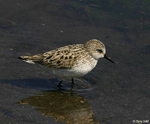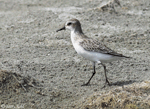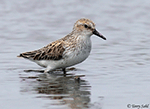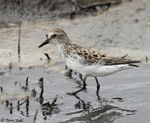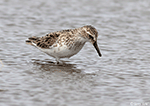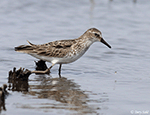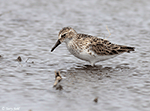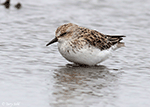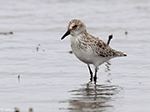| Length: 6.5 inches | Wingspan: 12 inches | Seasonality: Migrant |
| ID Keys: Short straight bill with relatively blunt tip, black legs, upperparts grayer than similar Western Sandpiper. | ||
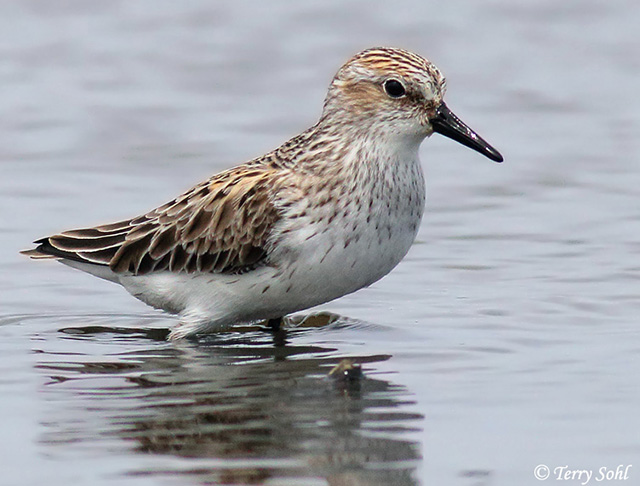 Semipalmated
Sandpipers are named for the slight webbing between their toes. One of the
so-called "peeps" (tiny sandpipers), they are nonetheless champion long-distance
migrants, often traveling for 2,000 miles non-stop from eastern North America to
their wintering grounds in South America. Once a abundant bird,
populations declined sharply in the 19th and 20th centuries due to direct
hunting and loss of habitat. Numbers started to rebound in the latter half of
the 20th century but have again started declining precipitously, due to
exploitation and direct hunting, as well as environmental and habitat influences
(see below).
Semipalmated
Sandpipers are named for the slight webbing between their toes. One of the
so-called "peeps" (tiny sandpipers), they are nonetheless champion long-distance
migrants, often traveling for 2,000 miles non-stop from eastern North America to
their wintering grounds in South America. Once a abundant bird,
populations declined sharply in the 19th and 20th centuries due to direct
hunting and loss of habitat. Numbers started to rebound in the latter half of
the 20th century but have again started declining precipitously, due to
exploitation and direct hunting, as well as environmental and habitat influences
(see below).
Habitat:
Found on open mudflats and edges of shallow lakes and wetlands during migration through the state.
Diet:
Feeds on a variety of small insects and crustaceans. Will also feed on small mollusks, worms, and occasionally seeds.
Behavior:
Primarily forages on mudflats, beaches, or very shallow water, walking along and searching for prey. They will also occasionally probe in the mud with their bill.
Breeding:
Non-breeder in South Dakota. On their breeding grounds in the Arctic, the nest is a shallow scrap on the ground, lined with grasses. The female lays 2 to 4 eggs, and both parents help to incubate them. Incubation lasts about three weeks, with the young fledging after another 2 to 3 weeks. The female usually abandons responsibility for raising the young about 3-5 days after hatching.
Song:
Semipalmated Sandpipers give a rolling, trilling call of ascending and descending tones, most often heard on its summer breeding grounds. The flight call is a short chirp.
- Click here to hear the trilling calls ofa Semipalmated Sandpiper on its breeding grounds1
- Click here to hear more calls of a Semipalmated Sandpiper2
- Click here to hear the alarm calls of a Semipalmated Sandpiper disturbed at its nest site3
Migration: Extremely long distance migrants, with summer breeding grounds in the Arctic, and its wintering grounds in South America.
Interactive eBird Map:
Click here to access an interactive eBird map of Semipalmated Sandpiper sightings
Similar Species:
One of multiple "peeps" that migrate through the state that have a similar size and structure. Semipalmated Sandpipers are most likely to be confused with the following species:
- Western Sandpiper - Western Sandpipers primarily migrate along the coast, but a few may be found migrating through the interior of the continent. They are similar in size and structure to a Semipalmated Sandpiper, but a Western Sandpiper often looks "chunkier" (difficult to judge on a lone bird, however). In breeding plumage, Western Sandpipers tend to be slightly more colorful, with a stronger rusty wash on the cap and below/behind the eye. Streaking on a Western Sandpiper also tends to extend down the flanks more than a Semipalmated Sandpiper. The bill of a Western Sandpiper also is a bit longer than that of a Semipalmated Sandpiper, and tends to look like it has a slight droop towards the end.
- Least Sandpiper - An even smaller peep! Least Sandpipers are smaller than a Semipalmated Sandpiper. The easiest way to differentiate the two, however, is leg color, as Least Sandpipers have yellow legs, while Semipalmated Sandpipers have black legs. Note that given their foraging habitats, muddy legs on a Least Sandpiper may result in the appearance of black legs.
- Sanderling - Sanderlings are an uncommon migrant in South Dakota, but could potentially be confused with a Semipalmated Sandpiper in both spring and winter plumage. Overall, Sanderlings are a larger bird (but again, size of a lone bird can be difficult to judge). In breeding plumage, Sanderlings are more colorful overall, with rusty colors that are more extensive on the head, and also extend to the upper breast and back. Non-breeding birds are similar, but Sanderlings have a very pale, almost silvery appearance, with very clean white undersides. Non-breeding Semipalmated Sandpipers lack the tinges of rusty tones of the breeding plumage bird, but aren't as pale as a Sanderling, and they also have a bit of diffuse streaking on the upper breast.
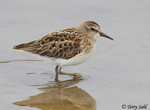 |
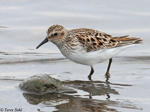 |
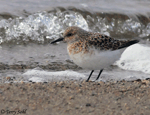 |
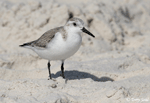 |
| Least Sandpiper | Least Sandpiper | Sanderling (Breeding) | Sanderling (non-breeding) |
Conservation Status:
Numbers are in decline in the last 20 years, with a number of potential causes. Thousands are killed by hunters on their wintering grounds in northern South America, with hunting in Suriname identified as being particularly egregious. In the United States, harvesting of horseshoe crabs has removed a vital food source as the birds move northward in the spring, likely resulting in reduced breeding condition. Pesticide use has also been linked to the decline, as has an exploding population of Snow Geese and Ross's Geese, species which has strongly impacted habitats on the breeding grounds of the Semipalmated Sandpiper. Overall, populations have been documented as declining by up to 80% just from the early 1980s to the present time. Overall populations are still strong but declining quickly, and due to the decline, the IUCN has designated the Semipalmated Sandpiper to be a species that is "Near Threatened".
Further Information:
- Birdweb - Semipalmated Sandpiper
- WhatBird - Semipalmated Sandpiper
- Audubon Guide - Semipalmated Sandpiper
Photo Information:
May 14th, 2004 -- Madison Waterfowl Production Area -- Terry Sohl
Additional Photos:
Click on the image chips or text links below for additional, higher-resolution Semipalmated Sandpiper photos.
Audio File Credits:
- 1Steve Hampton. Recorded in Safety Lagoon, Nome, Alaska on May 28th, 2018. Original recording and information available from xeno-canto.
- 2Paul Marvin. Recorded in Brevard County, Florida on May 10th, 2018. Original recording and information available from xeno-canto.
- 3Patrick Aberg. Recorded in Barrow on the North Slope of Alaska on June 14th, 2017. Original recording and information available from xeno-canto.
| Click on the map below for a higher-resolution view |
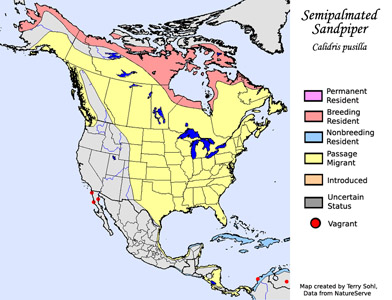 |
| South Dakota Status: Common migrant in suitable habitat throughout the state. |
Additional Semipalmated Sandpiper Photos
Click for a higher-resolution version of these photos
